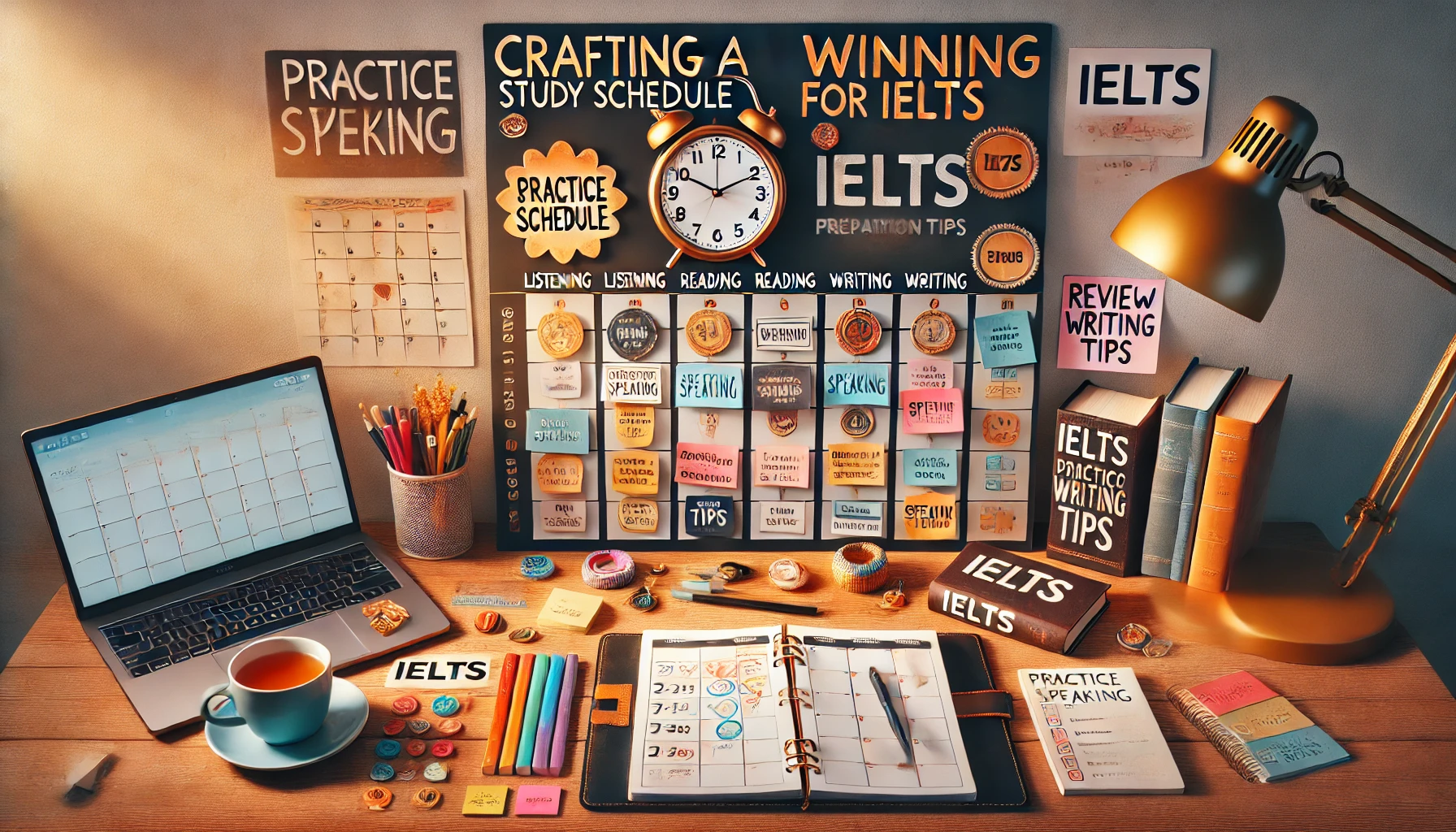A Step-by-Step Guide
Preparing for the IELTS (International English Language Testing System) can feel like navigating a maze, especially if you’re balancing a busy schedule with work, school, or family responsibilities. Despite the complexity, the key to an effective IELTS prep journey often lies in having a well-structured study schedule. A clear plan helps you stay organized, track your progress, and ultimately achieve the band score you’re aiming for. In this blog post, we’ll outline how to craft a winning study schedule that ensures you make the most of your study time and steadily boost your English proficiency.
1. Start With a Diagnostic Test
Before you even think about mapping out a schedule, it’s vital to establish your baseline. Taking a practice or diagnostic test—covering Reading, Writing, Listening, and Speaking—will show you:
- Current Skill Level: Identify which section (or sections) needs the most work.
- Strengths and Weaknesses: Maybe your Listening is already strong, but your Writing needs attention.
- Realistic Goals: A diagnostic test helps set clear, achievable band targets.
Think of it as your starting point: once you know your skill profile, you can create a tailored schedule that focuses on the areas that truly need improvement.
2. Define Clear Objectives
A study schedule without goals is like a trip without a destination. Set both short-term and long-term objectives:
- Short-Term Goals: For instance, “Complete 2 reading practice passages this week and achieve at least 75% accuracy.”
- Long-Term Goals: For example, “Raise my overall band from 6.0 to 7.0 in the next 10 weeks.”
These goals keep you motivated and allow you to measure progress in smaller increments. Moreover, they give you a sense of accomplishment whenever you hit a milestone.
3. Break Down Your Study Sessions
3.1. Weekly Overview
Start by allocating 5–6 days of study per week, depending on your other commitments. Decide on a light day or a complete rest day, which lets you recharge and reflect on what you’ve learned.
Example:
- Monday: Reading & Vocabulary
- Tuesday: Listening & Speaking
- Wednesday: Writing (Task 1 & Task 2)
- Thursday: Reading & Grammar
- Friday: Listening & Pronunciation Practice
- Saturday: Full Mock Test or Mixed Practice
- Sunday: Rest or light revision
3.2. Daily Breakdown
Within each study day, aim for focused blocks of 30–60 minutes per section. For instance:
- Block 1 (30 mins): Reading practice (skim/scan drills, or tackling specific question types).
- Block 2 (30 mins): Vocabulary work (flashcards, collocations, synonyms).
- Block 3 (30–60 mins): Section-specific tasks (Listening exercises, timed Writing tasks, etc.).
Insert short breaks (5–10 minutes) between blocks to stay fresh and prevent burnout.
4. Incorporate Core Skills and Realistic Practice
4.1. Core Skills: Reading, Listening, Writing, Speaking
Make sure each day (or each week, at minimum) addresses all four IELTS sections. Consistency is crucial. Frequent, focused practice helps your language abilities develop more organically than cramming one section at a time for days on end.
4.2. Timed Practice
IELTS is a time-pressured exam. Emulate test-day conditions by timing your Reading passages or Writing tasks. For example:
- Reading: Give yourself exactly 60 minutes for three passages.
- Writing: Practice finishing Task 2 in 40 minutes and Task 1 in 20 minutes.
This repetition helps you build stamina and learn to pace yourself efficiently.
4.3. Feedback and Review
- Writing: Seek feedback from teachers, study partners, or online communities. Identify recurring mistakes.
- Speaking: Record yourself and listen for clarity, filler words, and pronunciation.
- Reading/Listening: Always review the transcripts or answer explanations to pinpoint how and why you missed certain answers.
5. Use a Variety of Resources
Relying on a single textbook or question bank can lead to stale, limited practice. Balance official IELTS materials (which reflect the real exam format) with:
- Online videos (YouTube channels focusing on IELTS strategies)
- Podcasts (for Listening comprehension)
- News articles and magazines (to expand Reading variety and vocabulary)
- Study apps (for daily vocabulary flashcards or grammar quizzes)
This resource diversity keeps your sessions engaging and challenging at the right level.
6. Adjust and Adapt Your Schedule
Your study schedule should never be static. Instead, consider it a living plan that you update weekly or biweekly:
- Assess Progress: Check if you’re meeting the short-term goals set earlier.
- Tackle Weak Spots: If your Writing hasn’t improved, dedicate extra blocks to essays and feedback.
- Celebrate Milestones: Reward yourself when you reach certain targets (e.g., completing three consecutive weeks of full study).
Staying flexible prevents burnout and ensures you’re always prioritizing the skills that need the most attention.
7. Example of a 4-Week Study Schedule
Below is a simple outline you can modify based on your routine:
- Week 1:
- Focus: Diagnostic test, baseline reading/listening drills, basic essay structures
- Goals: Identify top 2 weak areas, create vocabulary list, review grammar essentials
- Week 2:
- Focus: Timed reading tests, targeted writing tasks, note-taking practice for listening
- Goals: Complete 2 full reading sets, 4 essay tasks, daily speaking recordings
- Week 3:
- Focus: Mock test under timed conditions, advanced collocations, pronunciation refinement
- Goals: Score improvement in Reading/Listening tests, reduce filler words in Speaking
- Week 4:
- Focus: Re-test, finalize areas for last-minute polishing
- Goals: Achieve near-target scores in all sections, schedule final rest day before test
Conclusion
An effective IELTS study schedule blends consistency, focus, and flexibility, ensuring each section of the exam is addressed in a balanced manner. By dedicating yourself to regular, timed practice—and by periodically evaluating and adjusting your plan—you can steadily boost your English skills and head into the exam with confidence. Remember that a solid schedule isn’t just about logging hours; it’s about the quality of your study sessions and the strategic focus you bring to each IELTS section.
Ready to get started? Begin by taking a practice test to establish your baseline, then map out your weekly and daily routines as suggested above. With dedication and the right approach, you’ll be well on your way to achieving your desired IELTS band score. Good luck!
For an in-depth look at the overall test structure, sections, and practical strategies, be sure to visit our Mastering the IELTS: Your Comprehensive Guide to the International English Language Testing System.

